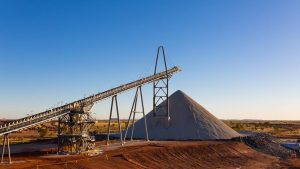Federal energy minister Angus Taylor made one significant admission on Friday in his speech about the proposed “technology roadmap” – the Coalition’s new marketing term to disguise its lack of action on climate and emissions.
Wind and solar, Taylor told a CEDA event in Sydney, are now commercially viable, quite obviously the cheapest source of new energy, and didn’t need more federal government support. Not many people would disagree with that.
What the renewable energy industry wants from Taylor, however, is not more subsidies. It wants a plan, and a target, and some effort from the government to smooth the transition to a zero carbon grid by removing the increasing number of regulatory and government hurdles Taylor seems determined to keep in their way.
Investment in wind and solar is falling away rapidly. And as the Clean Energy Regulator has pointed out, it’s not because the renewable energy target has been met and exceeded. There are powerful commercial reasons to invest in more wind and solar, including its substantially lower costs and increasing corporate and consumer demand.
What’s holding it up is a combination of factors that all point to a lack of government leadership: the policy uncertainty, the hostility of government ministers and backbenchers, insufficient infrastructure; out-of-date rules that make investment more risky; new rules that are proving counter-productive; a lack of co-ordination with the states; and modelling mistakes that have caused huge problems in western Victoria and south-west NSW.
Wind and solar are not just the cheapest forms of new generation, they are the reason why Australia’s electricity emissions have fallen so dramatically in recent years, and the Australian Energy Market Operator reckons they could easily cut electricity sector emissions by another 85 per cent over the next 20 years.

Not a bad place to be if your aim is to take the science seriously, and if you can also combine this with the electricifaction of transport, and many industries.
Indeed, AEMO’s 20-year blueprint says Australia can safely, securely, and at lower cost, use wind, solar, storage and demand management and navigate towards a grid that is 90 per cent renewable by 2041.
Plenty of energy experts think that can be done even quicker, but to do that the government needs to remove the regulatory impediments and rule-making obstinacy that is making new investment in wind and solar almost impossible.
But Taylor appears in no hurry to address any of these issues. Taylor has never been a great fan of so-called “intermittent technologies”, having campaigned on behalf of a particularly nasty internet group against wind energy before he became an MP, seeking to remove the renewable energy target once he was elected, and then declaring there was “too much wind and solar” once he became energy minister.
And he’s not alone. As Labor pointed out on Friday, over the past few weeks senior Coalition ministers have compared wind and solar to “dole bludgers” and the “new asbestos”; and the aversion to new technologies extends to batteries and electric vehicles, which the Coalition reckons are about as useful as a big banana, and will likely “end the weekend.”
So there was not much hope that Taylor and the Coalition would do the obvious – embrace the cheapest and cleanest sources of clean energy, and embrace the plans that could accelerate their integration into Australia’s grid.
Technology roadmaps might be an OK idea, and potentially useful for finding solutions to livestock emissions, but not if they are buried in ideology and denial, and if they ignore the obvious and cheapest solutions then they are complete waste of time.
Instead, Taylor’s speech focused mostly on the sort of technologies that will support fossil fuels such as coal and gas, rather than accelerating their exit. This is exactly what the fossil fuel industry and the right wing vandals in the government and conservative media want to hear.
Absurdly, Taylor is now proposing that the country ignore the cheap emissions abatement options and throw more money at things like carbon capture and storage, that has had more than half a billion thrown at it by the Australian government for no discernible outcome.
The other big focus was on hydrogen, and particularly fossil fuel hydrogen. Taylor was particularly enthusiastic about the Latrobe Valley brown coal hydrogen project, a pilot scheme that will spend $500 million to produce just three, yes, three tonnes of hydrogen.
“Whether it’s a migration from gas and coal to hydrogen or widespread use of low-cost geological and biological sequestration – it is crucial that we take that approach,”Taylor said. There was no mention of “green” or renewable hydrogen.
Taylor even had the cheek to say this: “It is crucial the government not crowd out private sector investment,” as he touted his Underwriting New Generation Investment scheme.
Yet that is exactly what UNGI has done – crowd out private investment. The scheme lacks transparency about its scale, scope and intent, and just serves as a road block. Just ask the CEOs of AGL, of Origin Energy, of Infigen Energy, or even the chair of the Energy Security Board. It’s so blindingly obvious to everyone, some wonder whether it is deliberate.
Taylor then went on to say this:
“We all know that the climate and emissions reduction challenge is truly one characterised by the tragedy of the commons.
“Where the net benefits of global emission reductions, whilst very real, are distant from the costs.
“It’s a debate that has become incredibly polarised.
“Between the keyboard warriors and the quiet Australians.
“Between the establishment and the disruptors.
“Between the inner-city and the outer-suburbs and regions.
“Between the opposition and the Government.
“Between emotion and economics.
“It is truly like no other agenda in modern Australia.”
He’s right on a couple of those points – the political aspect, the incumbents and the new players, and emotion and economics. But you need to tip it upside down and back to front to understand what’s really happened here.
The Coalition has struck out at every reasonable climate and energy policy for the past 10 years. Thankfully, it has not been 100 per cent successful, and the renewable energy target stayed in place, albeit reduced, and Clean Energy Finance Corporation and the Australian Renewable Energy Agency helped bring down the costs of key technologies, wind and solar, and now storage.
They are now, as Taylor admits, cost effective, and delivering significant emissions reductions.
Scott Morrison says no-one can tell him a pathway to cut emissions or how much it will cost. Perhaps he doesn’t get out much, or doesn’t get to hear from people other than the ex Minerals Council chiefs that dominate his inner coterie.
The experts have already mapped out pathways, whether it be to 90 per cent renewables (AEMO), a transition to zero emissions with considerable job, industry and economy-wide benefits (CSIRO), to a huge new renewable export industry (Garnaut, ARENA and many others); or the science, which says – above all – we must reduce our emissions to zero by 2050, and we must act quickly over the next decade.
Instead, the Coalition government shows no interest in anything much beyond obfuscation. It wants to dig up gas, fund new coal fired power station. Again, delay, delay, delay seems the primary goal.
Taylor fancies himself as a numbers man, and likes to say Australia only accounts for 1.3 per cent of global emissions, so why should it bother about zero emissions targets. But here’s a another number: Australia’s share of global losses from climate change events is estimated at 5.9 per cent. That is some sort of leverage to disaster, and some sort of exposure.
Any policy that ignores the urgency, and the technologies now at hand, is just insane. Although many in the industry point out that the architect is not, he know exactly what he is doing.
And it wouldn’t be the first time the Coalition has reached out for a “technology roadmap”, as Richie Merzian, the head of climate policy for The Australia Institute notes: John Howard produced a similar ruse more than two decades ago.
“The Howard Government used the promise of technology as the fig leaf to reject meaningful policy and reject the Kyoto Protocol, and all it did for Australia was keep emissions high and burn our international credibility,” Merzian says. “This Government risks repeating the same mistake.
Fig leafs. The Coalition is quite good at that. Remember Malcolm Turnbull’s description of Tony Abbott’s emissions reduction fund? Nothing much has changed.










